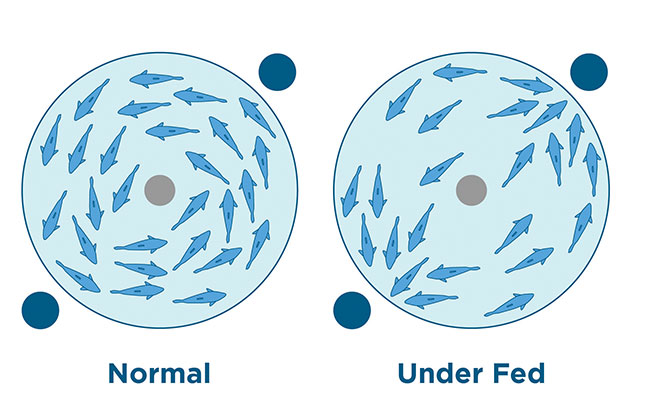
Features
Feeding and Nutrition
Fresh Tips: Understanding fish behaviour is key to optimize feeding
March 13, 2023 By Curtis Crouse, The Freshwater Institute
 Rendering of normal positioning for satiated fish and possible positioning of under fed fish under feeders (Photo: Freshwater Institute)
Rendering of normal positioning for satiated fish and possible positioning of under fed fish under feeders (Photo: Freshwater Institute) Feed and feeding management programs can encompass many components and considerations including feed formulation, ordering logistics, proper storage, and feeding procedures. Ultimately, the success of a feeding program hinges on striking the balance between under and overfeeding to maximize fish growth and prevent excessive waste.
Many feed vendors provide guidance on appropriate pellet size and ration for different size fish reared at different temperatures. These recommendations are a helpful starting point when beginning to offer feed to a newly stocked tank of fish. Careful observation of fish behaviour between and during feeding events can uncover key signs to help culturists fine tune the feed ration.
One key observation to make is the positioning of the fish in the culture tank. Assuming good water quality and health, satiated fish should be spread evenly around the culture tank. Underfed fish are likely to crowd around areas of the tank where feed is introduced or stack up underneath feeders waiting for the next meal. In this case, the next step is to determine why the fish are exhibiting this behavior. The solution may not be as simple as increasing the feed ration.
Watching fish as they mouth feed pellets can provide important clues to the suitability of the feed. For example, fish spitting pellets back into the water and ignoring them could indicate a problem with palatability stemming from factors including diet formulation or improper storage.
In this case, check expiration dates or try feed from another lot number if available. Spitting paired with head shaking or gill flaring behaviors and continued attempts at the spit pellet could indicate that the pellet size is too large for the fish ingest. In this case, continue feeding a smaller pellet and mixing the two pellet sizes when transitioning to a larger size.
With feed suitability confirmed, observing a feeding event can inform decisions to increase or decrease the feed ration. When feed is introduced to the tank, satiated fish should continue to hold even spacing throughout the tank and exhibit normal swimming behavior while capturing feed pellets as they come into range.
Near the end of a feeding event, fish should begin to ignore feed and a few waste pellets may fall to the bottom of the tank. If early into a scheduled feeding event fish are ignoring feed pellets and allowing them all to pass to the bottom of the tank, they may be over fed. In this case, culturists may need to reduce the feed ration to prevent waste. Fish that rush to the surface of the water or circle back several times against normal swimming direction to capture pellets, especially near the end of a feeding event, are likely underfed and need their ration increased.
More extreme behaviors such as fish breaking the water surface or non-bottom feeding fish retrieving feed from the bottom of a tank indicate a larger discrepancy between ration and appetite. Not only is this detrimental to optimal growth but can be stressful or cause injury to the fish. These extreme behaviors could be a sign of other problems.
For example, a failed or underperforming feeder or user programming errors could result in the equipment delivering less feed than expected and a growing appetite in the tank. To check if this is the case, collect and weigh the feed released from a feeder for a known time interval and compare it to calculations in the feed control programming.
Additionally, inadequate feed distribution around the tank or feeding at too fast of a rate could lead to capture issues where feed drops to the bottom of the tank faster than the hungry fish can consume it. In this case, increasing the ration will not help and a better feed delivery approach would be necessary. Try slowing down the feed rate, adding more feeders or daily events, or broadcasting the feed over a larger area of the tank.
At the conclusion of a regularly scheduled feeding event, fish should theoretically be satiated. This is a great opportunity for culturists to hand feed additional pellets to gauge the feeding response of the fish and make final decisions on feed ration size. In some cases, it is necessary to withhold feed from a tank for sampling, moving, or harvesting. When reintroducing feed, behaviours typical of underfed fish are expected to be on display. These events are a great opportunity to familiarize oneself with typical underfed behaviors to identify and correct them if they are observed unexpectedly in the future.
Print this page